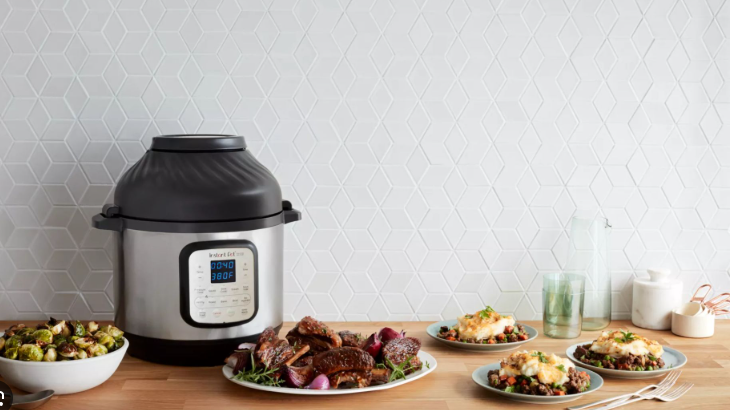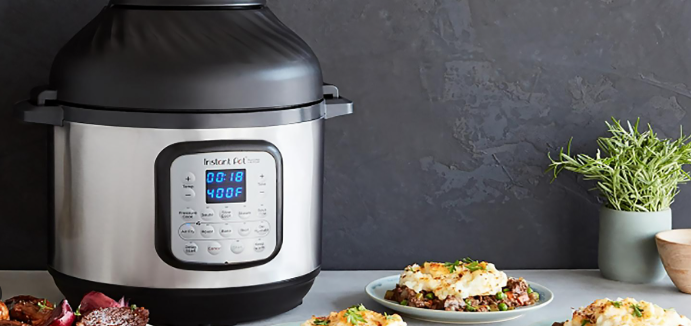Electric cookers, such as pressure cookers and multicookers, are essential kitchen appliances that streamline meal preparation with their versatility and efficiency. A common question among users is, how long does an electric cooker last? The lifespan of these appliances depends on factors like usage, maintenance, and build quality. This comprehensive guide explores the durability of electric cookers in 2025, offering insights into cooker setup, cooker maintenance, cooker safety, and cooker troubleshooting to maximize longevity. Whether you own a portable cooker like the Instant Pot Duo Mini or a high-end model like the Ninja Foodi, this best cooker guide will help you extend your cooker’s life. Let’s dive in!
Average Lifespan of an Electric Cooker
On average, a well-maintained electric cooker lasts 3–7 years, with high-quality models potentially lasting up to 10 years. Factors affecting longevity include:
- Build Quality: Premium brands like Instant Pot, Ninja, or CHEF iQ use durable materials, extending lifespan compared to budget models.
- Frequency of Use: Daily use wears components faster than occasional use.
- Maintenance: Regular cleaning and part replacements (e.g., sealing rings) prevent premature failure.
- Storage and Handling: Proper storage and careful handling reduce wear on components like lids and cords.
By understanding how long does an electric cooker last and implementing proper care, you can ensure your appliance remains reliable. For more insights, check out this electric cooker resource.

Factors That Impact Electric Cooker Longevity
1. Usage Patterns
Frequent use, especially for high-pressure cooking or air frying, puts more strain on components like the heating element and sealing ring. For example, daily pressure cooking may wear out the sealing ring in 12–18 months, while occasional use can extend its life to 2 years.
2. Build Quality and Brand
High-end models like the Instant Pot Pro Plus or Ninja Foodi Max use stainless steel pots and robust electronics, often lasting 5–10 years with proper care. Budget models may last 3–5 years due to lower-quality materials.
3. Maintenance Practices
Neglecting cooker maintenance—such as failing to clean the steam valve or replace worn parts—can shorten lifespan. Regular cleaning and timely replacements are key to longevity.
4. Environmental Factors
Exposure to humidity, extreme temperatures, or power surges can damage electronics or corrode parts. Using a surge protector and storing the cooker in a dry, cool place helps.
5. Handling and Storage
Rough handling, dropping the lid, or improper storage (e.g., stacking heavy items on the cooker) can damage components like the lid or control panel.
How to Extend the Life of Your Electric Cooker
To maximize how long does an electric cooker last, follow these best practices:
Cooker Setup: Starting Right
Proper cooker setup prevents early wear:
- Unpack Carefully: Inspect all components (pot, lid, sealing ring, steam valve) for damage before use.
- Clean Before Use: Wash the inner pot and accessories with warm, soapy water.
- Connect Electric Cooker: Plug into a stable, grounded outlet (700–1500 watts). Use a surge protector to prevent electrical damage.
- Water Test: Run a 5-minute pressure cycle with 1 cup of water to ensure proper function.
Visit cooker guide for detailed setup tips.
Cooker Maintenance: Routine Care
Regular cooker maintenance is crucial for longevity:
- Clean After Each Use: Wash the inner pot, lid, and accessories with soapy water or in a dishwasher (if safe). Avoid abrasive scrubbers to preserve nonstick coatings.
- Sealing Ring Care: Soak the silicone sealing ring in a baking soda solution (1 tbsp in 1 cup water) to remove odors. Replace every 12–18 months.
- Valve Cleaning: Clean the steam and float valves with a soft brush to prevent clogs.
- Exterior Cleaning: Wipe the outer housing with a damp cloth to remove splatters.
- Store Properly: Store in a dry, cool place with the lid upside down to maintain the sealing ring’s shape.
Replacing Worn Parts
Timely replacement of worn components prevents damage to the cooker:
- Sealing Ring: Replace if it’s cracked, warped, or retains odors ($8–$15).
- Inner Pot: Replace if scratched or dented ($15–$40).
- Steam/Float Valve: Replace if clogged or stuck ($5–$15).
- Power Cord: Replace if frayed or damaged ($10–$25).
Purchase parts from the manufacturer or authorized retailers to ensure compatibility.
Cooker Safety: Protecting Components
Cooker safety practices preserve your appliance:
- Avoid Overfilling: Respect the 2/3 fill line for pressure cooking to prevent strain on the sealing ring and valves.
- Handle Steam Carefully: Use mitts when releasing steam to avoid burns and protect the lid’s components.
- Use Stable Power: Avoid extension cords and use a surge protector to prevent electrical damage.
- Keep Away from Children: Use child lock features and store safely to avoid accidental damage.
Cooker Troubleshooting: Addressing Issues That Affect Lifespan
Promptly addressing issues can prevent damage that shortens your cooker’s life. Here are common problems and fixes:
- Burn Warning: Add at least 1 cup of thin liquid and scrape stuck food from the pot to prevent overheating.
- Steam Leaks: Check the sealing ring and lid alignment. Replace the ring if worn.
- No Power: Test the outlet and inspect the power cord. Unplug for 10 minutes to reset the control board.
- Slow Pressure Buildup: Clean or replace the steam and float valves to ensure proper sealing.
For detailed cooker troubleshooting, explore cooking tips.

Cooker Battery Life and Power Considerations
Electric cookers don’t rely on cooker battery life, as they require a constant power supply (700–1500 watts). However, power issues can affect longevity:
- Stable Power Source: Use a grounded outlet and avoid extension cords, which may not support the wattage.
- Surge Protection: A surge protector prevents damage from power spikes, especially for smart models with Wi-Fi.
- Off-Grid Use: For camping or RVs, use a generator or high-capacity power bank (e.g., 1000W for a portable cooker like the Instant Pot Duo Mini).
Frequent power surges or improper outlets can damage the heating element or control board, reducing lifespan.
Signs Your Electric Cooker Needs Replacement
While maintenance can extend life, some signs indicate it’s time to replace your cooker:
- Frequent Error Codes: Persistent codes like E1 (overheating) or C6 (pressure issues) after troubleshooting suggest internal faults.
- Damaged Heating Element: Burn marks or inconsistent heating may require costly repairs, making replacement more economical.
- Cracked Housing or Lid: Structural damage compromises safety and performance.
- Obsolete Technology: Older models lack modern features like smart connectivity, making an upgrade worthwhile.
Compare repair costs (e.g., $50–$100 for a heating element) to the price of a new cooker ($60–$300) to decide.
Cooker Tips to Maximize Lifespan
These cooker tips help ensure how long does an electric cooker last reaches its maximum potential:
- Use the correct liquid ratios (at least 1 cup for pressure cooking) to avoid strain on components.
- Avoid abrasive cleaners that damage nonstick coatings or electronics.
- Follow recipe guidelines to prevent overcooking or burning, which stresses the heating element.
- Replace worn parts promptly to avoid damaging other components.
- Use the cooker in a well-ventilated area to prevent overheating.
How to Use Electric Cooker for Longevity
Proper usage, as outlined in how to use electric cooker, reduces wear:
- Start with Simple Recipes: Master basic dishes like rice or steamed vegetables to avoid overloading the cooker.
- Use Presets: Leverage built-in modes (e.g., rice, stew) for consistent results and less strain on components.
- Avoid Overuse: Alternate with other cooking methods (e.g., stovetop) to reduce daily wear.
- Monitor Performance: Note any unusual noises or slow heating and address them promptly.
User Feedback on Electric Cooker Longevity
Users report that well-maintained electric cookers last 5–7 years on average. One user shared, “My Instant Pot Duo is 6 years old and still works perfectly with regular sealing ring replacements.” Another noted, “Cleaning the steam valve weekly keeps my Ninja Foodi running like new.” Some users with budget models report shorter lifespans (3–4 years) due to worn coatings or electrical issues, emphasizing the importance of quality and care.
Comparing Longevity Across Top 2025 Models
Instant Pot Duo Mini (3-Quart): Lasts 4–7 years with regular sealing ring and pot replacements. Its low wattage (700W) reduces electrical strain.
Ninja Foodi Max 15-in-1: Can last 5–10 years due to durable build, but frequent air frying may wear the heating element faster.
CHEF iQ Smart Pressure Cooker: Lasts 5–8 years with proper care, though smart features may require firmware updates to maintain performance.
Conclusion: Maximizing How Long Does an Electric Cooker Last
Understanding how long does an electric cooker last depends on usage, maintenance, and quality. With an average lifespan of 3–7 years, and up to 10 years for premium models, proper cooker setup, cooker maintenance, cooker safety, and cooker troubleshooting can significantly extend your appliance’s life. By cleaning regularly, replacing worn parts, and using your portable cooker correctly, you can enjoy years of reliable cooking. For more tips and recipes, visit electriccookerreview.com to explore the best cooker guide for your kitchen!